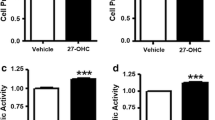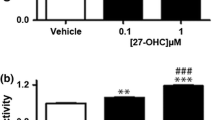Abstract
Metabolism of arachidonic acid through cyclooxygenase, lipoxygenase, or P450 epoxygenase pathways leads to the formation of various bioactive eicosanoids. In this review, we discuss alterations in expression pattern of eicosanoid-generating enzymes found during prostate tumor progression and expound upon their involvement in tumor cell proliferation, apoptosis, motility, and tumor angiogenesis. The expression of cyclooxygenase-2, 12-lipoxygenase, and 15-lipoxygenase-l are up-regulated during prostate cancer progression. It has been demonstrated that inhibitors of cyclooxygenase-2, 5-lipoxygenase and 12-lipoxygenase cause tumor cell apoptosis, reduce tumor cell motility and invasiveness, or decrease tumor angiogenesis and growth. The eicosanoid product of 12-lipoxygenase, 12(S)-hydroeicosatetraenoic acid, is found to activate Erkl/2 kinases in LNCaP cells and PKCα in rat prostate AT2.1 tumor cells. Overexpression of 12-lipoxygenase and 15-lipoxygenase-l in prostate cancer cells stimulate prostate tumor angiogenesis and growth, suggesting a facilitative role for 12-lipoxygenase and 15-lipoxygenase-l in prostate tumor progression. The expression of 15-lipoxygenase-2 is found frequently to be lost during the initiation and progression of prostate tumors. 15(S)-hydroxyeicosatetraenoic acid, the product of 15-lipoxygenase-2, inhibits proliferation and causes apoptosis in human prostate cancer cells, suggesting an inhibitory role for 15-lipoxygenase-2 in prostate tumor progression. The regulation of prostate cancer progression by eicosanoids, in either positive or negative ways, provides an exciting possibility for management of this disease.
Similar content being viewed by others
References
Norrish AE, Skeaff CM, Arribas GL, Sharpe SJ, Jackson RT: Prostate cancer risk and consumption of fish oils: A dietary biomarker-based case-control study. Br J Cancer 81: 1238–1242, 1999
Gupta S, Srivastava M, Ahmad N, Bostwick DG, Mukhtar H: Over-expression of cyclooxygenase-2 in human prostate adenocarcinoma. Prostate 42: 73–78, 2000
Lee LM, Pan CC, Cheng CJ, Chi CW, Liu TY: Expression of cyclooxygenase-2 in prostate adenocarcinoma and benign prostatic hyperplasia. Anticancer Res 21: 1291–1294, 2001
Yoshimura R, Sano H, Masuda C, Kawamura M, Tsubouchi Y, Chargui J, Yoshimura N, Hla T, Wada S: Expression of cyclooxygenase-2 in prostate carcinoma. Cancer 89: 589–596, 2000
Kirschenbaum A, Klausner AP, Lee R, Unger P, Yao S, Liu XH, Levine AC: Expression of cyclooxygenase-1 and cyclooxygenase-2 in the human prostate. Urology 56: 671–676, 2000
Uotila P, Valve E, Martikainen P, Nevalainen M, Nurmi M, Harkonen P: Increased expression of cyclooxygenase-2 and nitric oxide synthase-2 in human prostate cancer. Urol Res 29: 23–28, 2001
Subbarayan V, Sabichi AL, Llansa N, Lippman SM, Menter DG: Differential expression of cyclooxygenase-2 and its regulation by tumor necrosis factor-alpha in normal and malignant prostate cells. Cancer Res 61: 2720–2726, 2001
Tjandrawinata RR, Dahiya R, Hughes-Fulford M: Induction of cyclo-oxygenase-2 mRNA by prostaglandin E2 in human prostatic carcinoma cells. Br J Cancer 75: 1111–1118, 1997
Liu XH, Yao S, Kirschenbaum A, Levine AC: NS398, a selective cyclooxygenase-2 inhibitor, induces apoptosis and down-regulates bcl-2 expression inLNCaPcells. Cancer Res 58: 4245–4249, 1998
Hsu AL, Ching TT, Wang DS, Song X, Rangnekar VM, Chen CS: The cyclooxygenase-2 inhibitor celecoxib induces apoptosis by blocking Akt activation in human prostate cancer cells independently of Bcl-2. J Biol Chem 275: 11397–11403, 2000
Lim JT, Piazza GA, Han EK, Delohery TM, Li H, Finn TS, Buttyan R, Yamamoto H, Sperl GJ, Brendel K, Gross PH, Pamukcu R, Weinstein IB: Sulindac derivatives inhibit growth and induce apoptosis in human prostate cancer cell lines. Biochem Pharmacol 58: 1097–1107, 1999
Liu XH, Kirschenbaum A, Yao S, Stearns ME, Holland JF, Claffey K, Levine AC: Upregulation of vascular endothelial growth factor by cobalt chloride-simulated hypoxia is mediated by persistent induction of cyclooxygenase-2 in a metastatic human prostate cancer cell line. Clin Exp Metastasis 17: 687–694, 1999
Liu XH, Kirschenbaum A, Yao S, Lee R, Holland JF, Levine AC: Inhibition of cyclooxygenase-2 suppresses angiogenesis and the growth of prostate cancer in vivo. J Urol 164: 820–825, 2000
Tsujii M, Kawano S, DuBois RN: Cyclooxygenase-2 expression in human colon cancer cells increases metastatic potential. Proc Natl Acad Sci USA 94: 3336–3340, 1997
Attiga FA, Fernandez PM, Weeraratna AT, Manyak MJ, Patierno SR: Inhibitors of prostaglandin synthesis inhibit human prostate tumor cell invasiveness and reduce the release of matrix metalloproteinases. Cancer Res 60: 4629–4637, 2000
Gupta S, Srivastava M, Ahmad N, Sakamoto K, Bostwick DG, Mukhtar H: Lipoxygenase-5 is overexpressed in prostate adenocarcinoma. Cancer 91: 737–743, 2001
Shappell SB, Boeglin WE, Olson SJ, Kasper S, Brash AR: 15–lipoxygenase-2 (15–LOX-2) is expressed in benign prostatic epithelium and reduced in prostate adenocarcinoma. Am J Pathol 155: 235–245, 1999
Anderson KM, Seed T, Vos M, Mulshine J, Meng J, Alrefai W, Ou D, Harris JE: 5–Lipoxygenase inhibitors reduce PC-3 cell proliferation and initiate nonnecrotic cell death. Prostate 37: 161–173, 1998
Ghosh J, Myers CE: Inhibition of arachidonate 5–lipoxygenase triggers massive apoptosis in human prostate cancer cells. Proc Natl Acad Sci USA 95: 13182–13187, 1998
Dixon RA, Diehl RE, Opas E, Rands E, Vickers PJ, Evans JF, Gillard JW, Miller DK: Requirement of a 5–lipoxygenaseactivating protein for leukotriene synthesis. Nature 343: 282–284, 1990
Vickers PJ: 5–Lipoxygenase-activating protein (FLAP). J Lipid Mediat Cell Signal 12: 185–194, 1995
Datta K, Biswal SS, Xu J, Towndrow KM, Feng X, Kehrer JP: A relationship between 5–lipoxygenaseactivating protein and bcl-xL expression in murine pro-B lymphocytic FL5.12 cells. J Biol Chem 273: 28163–28169, 1998
Datta K, Biswal SS, Kehrer JP: The 5–lipoxygenaseactivating protein (FLAP) inhibitor, MK886, induces apoptosis independently ofFLAP. Biochem J 340: 371–375, 1999
Kehrer JP, Biswal SS, La E, Thuillier P, Datta K, Fischer SM, Vanden Heuvel JP: Inhibition of peroxisome-proliferatoractivated receptor (PPAR)alpha by MK886. Biochem J 356: 899–906, 2001
Honn KV, Tang DG, Gao X, Butovich IA, Liu B, Timar J, Hagmann W: 12–lipoxygenases and 12(S)-HETE: Role in cancer metastasis. Cancer Metastasis Rev 13: 365–396, 1994
Hagmann W, Gao X, Zacharek A, Wojciechowski LA, Honn KV: 12–Lipoxygenase in Lewis lung carcinoma cells: Molecular identity, intracellular distribution of activity and protein, and Ca(2+)-dependent translocation from cytosol to membranes. Prostaglandins 49: 49–62, 1995
Chen YQ, Duniec ZM, Liu B, Hagmann W, Gao X, Shimoji K, Marnett LJ, Johnson CR, Honn KV: Endogenous 12(S)-HETE production by tumor cells and its role in metastasis. Cancer Res 54: 1574–1579, 1994
Liu B, Marnett LJ, Chaudhary A, Ji C, Blair IA, Johnson CR, Diglio CA, Honn KV: Biosynthesis of 12(S)-hydroxyeicosatetraenoic acid by B16 amelanotic melanoma cells is a determinant of their metastatic potential. Lab Invest 70: 314–323, 1994
Silletti S, Timar J, Honn KV, Raz A: Autocrine motility factor induces differential 12–lipoxygenase expression and activity in high-and low-metastatic K 1735 melanoma cell variants. Cancer Res 54: 5752–5756, 1994
Gao X, Grignon DJ, Chbihi T, Zacharek A, Chen YQ, Sakr W, Porter AT, Crissman JD, Pontes JE, Powell IJ, Honn KV: Elevated 12–lipoxygenase mRNA expression correlates with advanced stage and poor differentiation of human prostate cancer. Urology 46: 227–237, 1995
Nie D, Hillman GG, Geddes T, Tang K, Pierson C, Grignon DJ, Honn KV: Platelet-type 12–lipoxygenase in a human prostate carcinoma stimulates angiogenesis and tumor growth. Cancer Res 58: 4047–4051, 1998
Connolly JM, Rose DP: Enhanced angiogenesis and growth of 12–lipoxygenase gene-transfected MCF-7 human breast cancer cells in athymic nude mice. Cancer Lett 132: 107–112, 1998
Timar J, Tang D, Bazaz R, Haddad MM, Kimler VA, Taylor JD, Honn KV: PKC mediates 12(S)-HETE-induced cytoskeletal rearrangement in B16a melanoma cells. Cell Motil Cytoskeleton 26: 49–65, 1993
Ulbricht B, Hagmann W, Ebert W, Spiess E: Differential secretion of cathepsins B and L from normal and tumor human lung cells stimulated by 12(S)-hydroxyeicosatetraenoic acid. Exp Cell Res 226: 255–263, 1996
Timar J, Bazaz R, Kimler V, Haddad M, Tang DG, Robertson D, Tovari J, Taylor JD, Honn KV: Immunomorphological characterization and effects of 12–(S)-HETE on a dynamic intracellular pool of the alpha IIb beta 3–integrin in melanoma cells. J Cell Sci 108: 2175–2186, 1995
Honn KV, Grossi IM, Diglio CA, Wojtukiewicz M, Taylor JD: Enhanced tumor cell adhesion to the subendothelial matrix resulting from 12(S)-HETE-induced endothelial cell retraction. FASEB J 3: 2285–2293, 1989
Liu B, Khan WA, Hannun YA, Timar J, Taylor JD, Lundy S, Butovich I, Honn KV: 12(S)-hydroxyeicosatetraenoic acid and 13(S)-hydroxyoctadecadienoic acid regulation of prote in kinase C-alpha in melanoma cells: Role of receptormediated hydrolysis of inositol phospholipids. Proc Natl Acad Sci USA 92: 9323–9327, 1995.
Szekeres CK, Tang K, Trikha M, Honn KV: Eicosanoid activation of extracellular signal-regulated kinase1/2 in human epidermoid carcinoma cells. J Biol Chem 275: 38831–38841, 2000
Szekeres CK, Trikha M, Nie D, Honn KV: Eicosanoid 12(S)-HETE activates phosphatidylinositol 3–kinase. Biochem Biophys Res Commun 275: 690–695, 2000
Liu B, Maher RJ, Hannun YA, Porter AT, Honn KV: 12(S)-HETE enhancement of prostate tumor cell invasion: Selective role of PKC alpha. J Natl Cancer Inst 86: 1145–1151, 1994
Tang DG, Chen YQ, Honn KV: Arachidonate lipoxygenases as essential regulators of cell survival and apoptosis. Proc Natl Acad Sci USA 93: 5241–5246, 1996
Nie D, Tang K, Diglio C, Honn KV: Eicosanoid regulation of angiogenesis: Role of endothelial arachidonate 12–lipoxygenase. Blood 95: 2304–2311, 2000
Brash AR, Boeglin WE, Chang MS: Discovery of a second 15S-lipoxygenase in humans. Proc Natl Acad Sci USA 94: 6148–6152, 1997
Spindler SA, Sarkar FH, Sakr WA, Blackburn ML, Bull AW, LaGattuta M, Reddy RG: Production of 13–hydroxyoctadecadienoic acid (13–HODE) by prostate tumors and cell lines. Biochem Biophys Res Commun 239: 775–781, 1997
Kelavkar UP, Badr KF: Effects of mutant p53 expression on human 15–lipoxygenase-promoter activity and murine 12/15–lipoxygenase gene expression: Evidence that 15–lipoxygenase is a mutator gene. Proc Natl Acad Sci USA 96: 4378–4383, 1999
Kelavkar UP, Cohen C, Kamitani H, Eling TE, Badr KF: Concordant induction of 15–lipoxygenase-1 and mutant p53 expression in human prostate adenocarcinoma: Correlation with Gleason staging. Carcinogenesis 21: 1777–1787, 2000
Jack GS, Brash AR, Olson SJ, Manning S, Coffey CS, Smith JA Jr, Shappell SB: Reduced 15–lipoxygenase-2 immunostaining in prostate adenocarcinoma: Correlation with grade and expression in high-grade prostatic intraepithelial neoplasia. Hum Pathol 31: 1146–1154, 2000
Kelavkar UP, Nixon JB, Cohen C, Dillehay D, Eling TE, Badr KF: Overexpression of 15–lipoxygenase-1 in PC-3 human prostate cancer cells increases tumorigenesis. Carcinogenesis 22: 1765–1773, 2001
Han KH, Chang MK, Boullier A, Green SR, Li A, Glass CK, Quehenberger O: Oxidized LDL reduces monocyte CCR2 expression through pathways involving peroxisome proliferator-activated receptor gamma. J Clin Invest 106: 793–802, 2000
Forman BM, Chen J, Evans RM: Hypolipidemic drugs, polyunsaturated fatty acids, and eicosanoids are ligands for peroxisome proliferator-activated receptors alpha and delta. Proc Natl Acad Sci USA 94: 4312–4317, 1997
Kawahito Y, Kondo M, Tsubouchi Y, Hashiramoto A, Bishop-Bailey D, Inoue K, Kohno M, Yamada R, Hla T, Sano H: 15–deoxy-delta(12,14)-PGJ(2) induces synoviocyte apoptosis and suppresses adjuvant-induced arthritis in rats. J Clin Invest 106: 189–197, 2000
Kubota T, Koshizuka K, Williamson EA, Asou H, Said JW, Holden S, Miyoshi I, Koeffler HP: Ligand for peroxisome proliferator-activated receptor gamma (troglitazone) has potent antitumor effect against human prostate cancer both in vitro and in vivo. Cancer Res 58: 3344–3352, 1998
Shappell SB, Gupta RA, Manning S, Whitehead R, Boeglin WE, Schneider C, Case T, Price J, Jack GS, Wheeler TM, Matusik RJ, Brash AR, Dubois RN: 15S-Hydroxyeicosatetraenoic acid activates peroxisome proliferator-activated receptor gamma and inhibits proliferation in PC3 prostate carcinoma cells. Cancer Res 61: 497–503, 2001
Author information
Authors and Affiliations
Rights and permissions
About this article
Cite this article
Nie, D., Che, M., Grignon, D. et al. Role of Eicosanoids in Prostate Cancer Progression. Cancer Metastasis Rev 20, 195–206 (2001). https://doi.org/10.1023/A:1015579209850
Issue Date:
DOI: https://doi.org/10.1023/A:1015579209850




